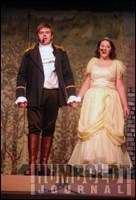Opening night of Dec. 13 and the seats were packed with people coming to see the Beauty and the Beast Jr. play performed by students from Humboldt Collegiate Institute (HCI).
While the title of the show might lead some to believe it would be a younger allegory of the traditional fable, the performance was as Disney-fied as ever. It included famous numbers such as "Be Our Guest" and "Gaston," which had strong moments and some not so strong. Directed by Glenda Lees, the performance became a string of spotlight moments interspersed with flat-lining recitation.
The lead character of Belle, performed by Danielle Guina, could easily be considered the glue that held the piece together.
She was animated, vivid, and easily dominated the stage. Her facial expressions and hand gestures were used to their fullest advantage, as were the intonations in her speech and singing. The character's unassuming and yet bold presence was certainly brought to life on stage.
However, where Guina excelled, Gaston's performance fell somewhat flat. The character, played by Josh Lees, was strong only in the volume of his voice. Although the effort was there, the facial expressions and body language was not. He pulled off the arrogance of Gaston's supercilious character, but the range and nuances of Gaston came to a halt there.
The counter to this was the brilliant presentation put on by Dawson Keller who played the Beast in all his furry glory. While it may have resulted in hours of sucking on a lozenge, Keller's jagged voice portrayed a persona that was full of agitated anger and annoyance. When the character transformed, so did his voice, becoming gentler and less gruff. Nevertheless, those shining performances weren't enough to hide some of the overlying flaws in the show.
While everyone said the right words at the right times, their intonation may have been hampered by the sheer rapidity of the show's pace. It was like watching a drill march at times, whereby actors came on stage, recited their lines, and promptly left. Hardly anyone stopped to take a breath.
Despite this, there were some hidden stars that appeared at times to soften the harsh recitation, and those came in the form of a few key secondary characters. Lefou, played by Landon Selinger, was a not-so-bumbling character as much as he was a welcome comedic respite from the dreary monotone of his character's idol. He quipped in at the right moment with bright smiles and sarcastic remarks, hopping from spot to spot about the stage and occasionally into someone's arms. He was indeed a hilarious parody of his big-nosed, vertically-challenged animated counterpart.
Then there were the milkmaids. While originally characterized as an identical triplet of simpering, coquettish, shallow girls, these roles were instead condensed down into two roles. The "silly girls," played by Faith Schuler and Emily Engele, were vocal and occasionally shrill, but musically inclined and beautiful. They added a colourful charm on stage that even occasionally overshadowed the main actors and actresses.
Overall, the theatrical drama was a success due mainly to the sheer hard work of its participating members. The effort in Lees' direction could clearly be seen in the placement of every person and the timing of their lines. While the background actors could have employed a stronger voice, the nuance of talent was still present. LumiÈre's accent remained surprisingly strong, even throughout his singing, and Cogsworth was marvelous as a plump and stuffy sycophant.
Of course, it would be a crime to not mention the beauty and accuracy of the costumes present. Belle's iconic yellow/gold dress was the finishing touch on her performance, as were the manifestations of Madame de la Grande Bouche's physical proportions and Cogsworth's clock appearance.
In the end, hats off and a standing ovation to the coordinators, actors, actresses and helping hands that made this performance a sensation.

.png;w=120;h=80;mode=crop)


